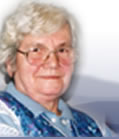THEMES IN THIS
TESTIMONY
Culture and Customs

Education

Migration

Click on arrows
to find more
testimonies
featuring
these themes
|
|
Sex
|
female
|
|
|
Age
|
39
|
|
|
Occupation
|
artist
|
|
|
Location
|
Katy Bystrzyckie
|
|
|
Date
|
August 1999
|
|
summary
The narrator is an artist, who moved to the area with her husband after a brief visit to Stara Lomnica. She believed that the terrain, the sense of space and the silence was more suited to her creative spirit than the bustle of the city. Life in the country is like a “blank sheet of paper, there’s little drawn on it, you can always add things to it, can’t you? … Compared to town, this is a complete wilderness, emptiness”. Like some of the intelligentsia declasse who left urban and public life in the 70s and 80s, her “voluntary exile” has brought frustration and loneliness as well as fulfilment. It has given her “a chance to be, to be silent, to think, not to rush along with the rat race, to begin to understand, not to hurry, absolutely not to hurry, to stop from time to time”, but she also feels misunderstood, an outsider. “Sometimes, very sporadically, I meet someone like myself. That is a problem because you need to talk about it, to confront your views with someone else”. She remembers her excitement when she heard that a composer was moving to the area: “It was great news to me! I thought, hell, a composer, a musician … they’ve got some spiritual needs as well”.
Physically, the move has been tough – the house is damp, transport is problematic, and she is dismissive of the local schools - but there is a “strength of mine which... will not let me write ‘The End’.” She has set up an academy for local children, where they can develop their innate artistic sensibilities – something she feels the school system, based around rote learning, and the lack of local facilities, otherwise stifles. “Even the children who live in Ladek don’t have anything to do there. There’s nothing in Ladek. And here I am with a child who commutes to school by bus and... and what else? If he wanted to swim, I’d probably have to get myself a helicopter or at least a car. The main problem is access to anywhere [for] all the children around. I know children who come from very poor families, but they have lots of talents. And they have no chance to develop....”
Despite the problems, she has “learnt to respect these people who live here....Because at first, I looked at them with indifference, even with some sort of pity, because they were to me people who cannot arrange their lives a bit better. And now I respect them because they have endured the hardships of this land and stayed here anyway.”
detailed breakdown
|
You will need a password from Panos to view the full
transcript of the interview. To apply for a password, click here.
Once you have a password, click here to go to the beginning
of the transcript. You can also click on any section of the
breakdown of content below and go straight to the
corresponding part of the transcript.
|
| Section 1-2 |
How she visited the area to help renovate a kiln and “when we found ourselves here, in that seclusion … some sort of subconscious decision must have been made” and so they decided to move. Some family history
|
| Section 3 |
She might like to move away from the area some time, or at least visit other places and travel, “but the costs would be enormous”.
|
| Section 4 |
Her art: she feels that her development has got slower since moving to the area, “but I don’t think that’s anything bad. If you do things slowly, you do them more carefully”.
|
| Section 5 |
How she tries to depict the unity of nature: “I don’t want to depict the grass, the tree, the fence in isolation from one another. I want, however difficult it is, to show all those objects speaking together”.
|
| Section 6 |
She feel living in the mountain environment gives local children greater sensitivity to their surroundings but “the kids around here don’t have anywhere to develop their talents, they don’t have the basic things that kids in towns do, in large cities. But what do they have? They have the silence”.
|
| Section 7 |
Problems she had renovating and constructing her house.
|
| Section 8 |
Says she gets no money from the authorities and relies on assistance from a few people for her art and “her mission” of a Children’s Academy.
The mixed reaction she had from local people when she first arrived.
|
| Section 9 |
She does feel isolated and lacks anyone she can communicate with on her level. She has given up hope that others will understand her, particularly the authorities (who could support the academy more).
|
| Section 10 |
What she most misses about town-life is the ease with which she can get about and buy materials. Otherwise she doesn’t “need” the town; there is “too little inspiration there”.
|
| Section 11-12 |
Feels there are not many people interested in her and her work: “the great big world is in a terrible hurry these days”.
|
| Section 13-14 |
Her opinion of local schools: “the point is, they don’t offer anything. They offer a lot of lessons, rote learning. Which means if you learn something that they told you to learn, you get a good mark and that’s all there is to it”.
She has learnt respect for local people because “they survived, endured [difficult conditions]. They are ill people, most of them, but you will not hear them cursing at their lives.”
|
| Section 15-16 |
Thinks that some people treat her “like a mad woman. I will not bend, I will not stoop to paint easy pictures to get money”.
|
| Section 15 |
Discusses what living in the mountains means to her: the variety of shape and colour and the constantly changing light and landscape means “having your perception intensified. Not repeated, but intensified. Because, if it were a flat land, that would be like having just one composition....Here you could practically paint one motif every day, and you would get a different picture each time.” |
|


